

Gluten free shortbread cookies are the simplest cookies with the fewest ingredients, so let's make the same base recipe into 5 different varieties: plain, glazed lemon, mocha, toffee caramel and berry chip. Or mix and match for the most beautiful cookie plate ever!
This foolproof recipe for gluten free shortbread cookies quickly and easily makes 5 varieties: plain, glazed lemon, mocha, toffee caramel and berry chip. The simplest recipes really are the best!
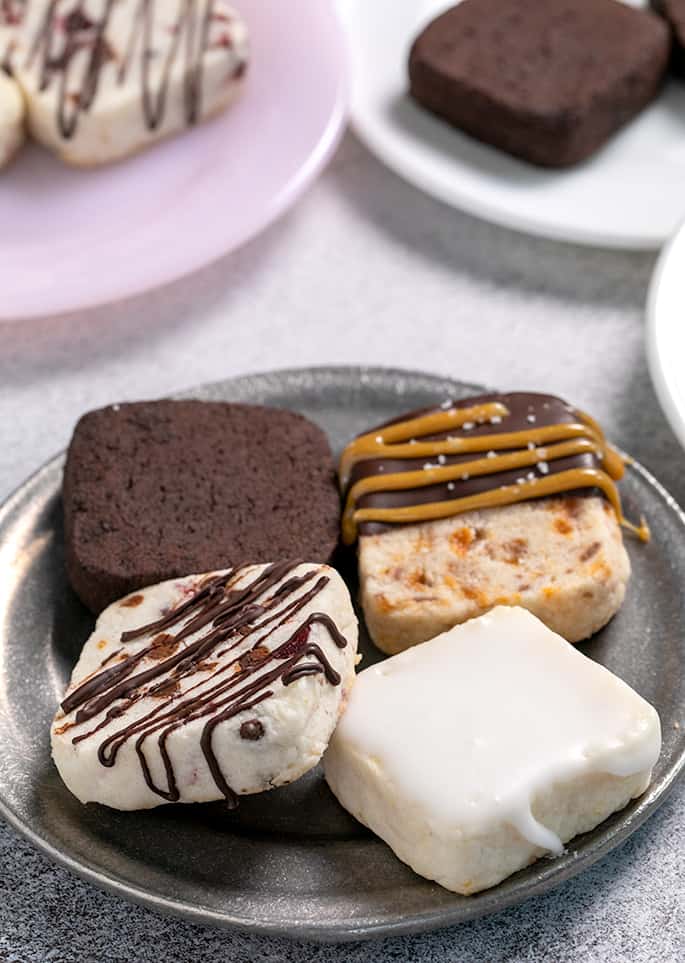
What makes this the best recipe for gluten free shortbread cookies
For each of these 5 recipes, we start off the same—with a gluten free shortbread cookies mix. And since shortbread cookies are pretty much the absolute simplest cookies around, that mix is dead simple: some flours, sugar, and salt.
The “plain” recipe below is really the only one you need. Use the proportions for each variety to make them your own—for each recipe of shortbread cookie dry mix, you'll need 8 tablespoons of unsalted butter.
Beyond that, add 1/3 cup of mix-ins (like chopped dried fruit, mini chocolate chips, toffee bits or any other tiny mix-ins). Drizzle with chocolate, top with cinnamon sugar, sugar-in-the-raw, or mocha sugar. You get the idea!
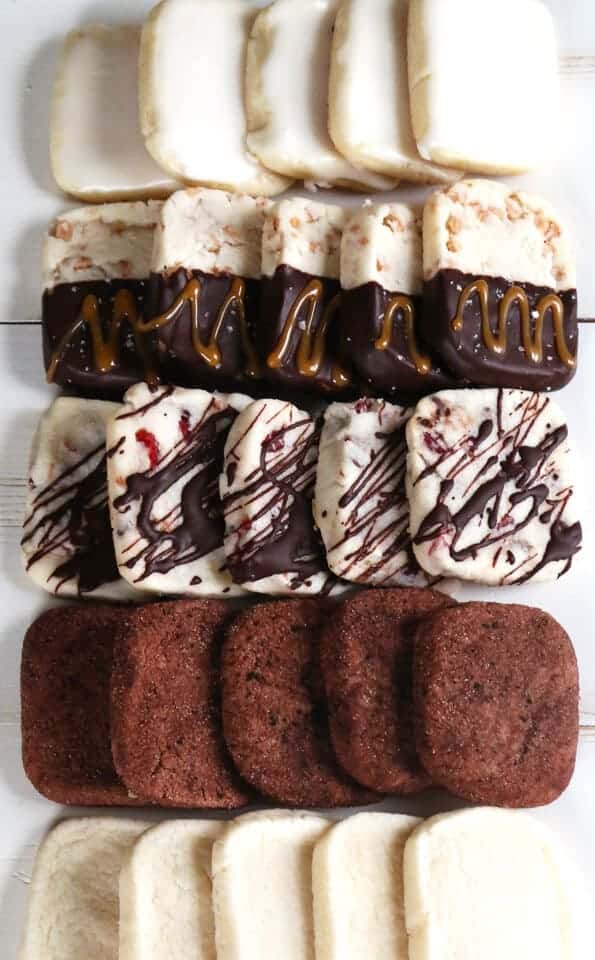
Gluten free shortbread cookies: the basic method
The basic recipe can be used with the simple addition of unsalted butter and a little water, as needed, to make plain shortbread cookies. Just mix everything together, knead and shape the cookie dough into a rectangle about 1 1/2-inches thick, wrap it tightly and refrigerate until firm.
Then, slice the cookies by cross-section, place on a baking sheet, and bake for less than 10 minutes. You can even make and shape the raw cookie dough and store it for weeks in the refrigerator before slicing and baking.
If you refrigerate the dough for longer like that, it will become too stiff to slice. Just allow it to sit at room temperature until you can slice it easily, and proceed with the recipe as written.
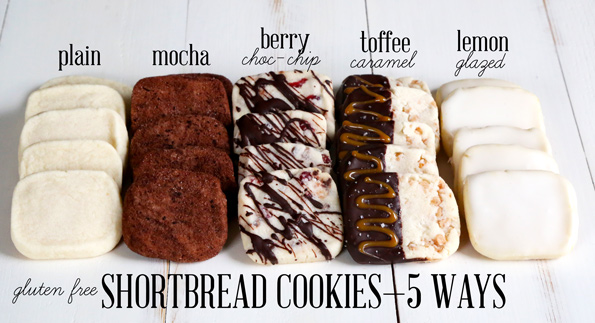
Tips for preparing all these awesome gluten free shortbread cookies
Measuring out ingredients for gluten free shortbread cookies
If you plan to make all 5 kinds of shortbread cookies, multiply all the shortbread cookie mix ingredients by 5, and whisk to combine well. You can also multiply the basic plain mix by 2.5 (for a total of 863 grams), and make 1/2 recipe for each variety.
If you're making a full recipe of any variety, measure out 345 grams of the well-combined dry mix for each recipe. If you're making a half recipe, measure out 173 grams.
Then, proceed with the instructions as written for each, dividing all the remaining ingredients by half if you're making a half recipe of each (or any) variety. You'll be amazed at how quickly you can make a bunch of cookie flavors. Talk about impressive!
Working with your gf shortbread dough
Because there isn't a lot of moisture in this gluten free shortbread cookies recipe, it will seem like your dough isn't coming together, but I promise: it will! Just keep mixing until it forms a soft dough, but don't over-mix; otherwise, your finished product may come out super delicate and crumbly.
When it's ready, roll out your dough until it's about ⅜-inch thick. You can do this over a piece of parchment paper that's been lightly dusted with gf flour.
When you reach the right thickness, cut the dough using a knife or pizza cutter for square or rectangular cookies, or cookie cutters for other shapes.
If you use cookie cutters, you may end up with a lot of scraps. Don't you dare throw them away! Because there's no gluten that can toughen up with continued handling, you can re-roll your dough over and over again until you've used it all.
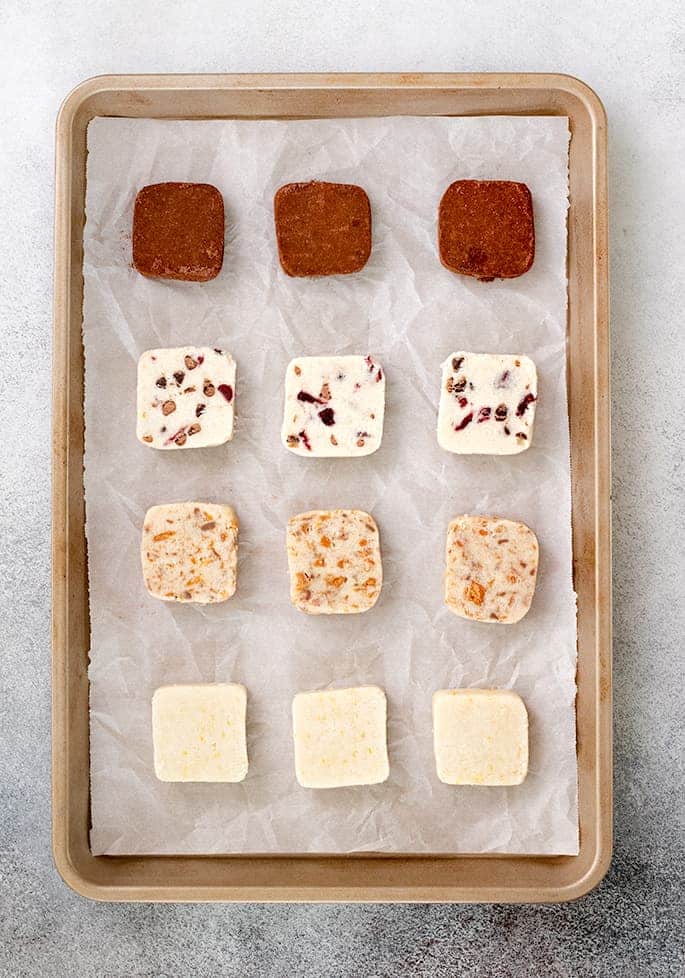
How to make gluten free mocha shortbread cookies
Mocha cookies are made with the addition of some cocoa powder and instant espresso powder to the basic shortbread dough. The real magic happens when you dip each slice of cookie dough in a coating of cocoa powder and granulated sugar.
How to make gluten free berry chip shortbread cookies
For the berry chocolate chip cookies, just add dried berries and mini chocolate chips to the dry mix. I like dried cranberries and miniature chocolate chips, but you could add all mini chips and make them chocolate chip.
You could also try chopped nuts (walnuts, pecans, or pistachios are all great soft nuts) in place of dried berries. The chocolate drizzle adds a bit of extra chocolate flavor and lots of charm, but isn't strictly necessary.
How to make gluten free toffee caramel shortbread cookies
Toffee caramel cookies are by far the fanciest, since they are made with toffee bits mixed into the basic dough, then dipped in chocolate and drizzled with caramel.
How to make gluten free glazed lemon shortbread cookies
Glazed lemon gluten free shortbread is made fresh and lemony with lemon juice lemon zest, then topped with a simple lemon glaze. I used to add a bit of “True Lemon,” which is a granulated lemon “seasoning blend.” I've swapped that out for lemon juice, instead.
Not everyone has or can find True Lemon, but if you do have it, try adding about a teaspoonful to the recipe as written for a ton of lemon flavor. There are other True flavors, and they're all worth trying!

Ingredients in these gluten free shortbread cookies
Choosing the right gluten free flour blend
I must stress that, as always, the all purpose gluten free flour blend that you use matters—a lot. It always matters and it matters even more in an incredibly simple recipe like this.
Each time a blog recipe calls for an all purpose gluten free flour, I link to the page on the blog that has all the details about which blends I caution against, and which are appropriate. If you only have a blend like Bob's Red Mill, which I warn against strongly, or Namaste, which I also caution against, I cannot promise results.
In fact, if you have success with something like Bob's Red Mill flour blend, I can't promise repeat results. The blend is inconsistent, which is a large part of my concerns with it.
Using a poorly balanced flour blend or one that has gritty rice flour, then promising that you followed the recipe “to a T” and blaming the recipe for the failure is like using someone else's recipe and looking to this site to fix it.
Dipping your gluten free shortbread cookies in chocolate
I love coating my gf shortbread cookies in chocolate, whether that involves dipping, drizzling, or a combo of the two.
I find that the best way to work with chocolate is to use semi-sweet mini chips. Place them in a microwave-safe bowl and melt them 20 seconds at a time, stirring after each zap, until they reach the right consistency. If you're making an extra-large batch of cookies, you might find a double boiler to be more convenient.
When the melted chocolate is ready, simply dip a cooled cookie into it. You can dip a third of the cookie, half of the cookie, or the whole top or bottom. Be sure to tap off any extra chocolate, and then place the cookie on a parchment-paper-lined baking sheet so that the chocolate can firm back up.
Gluten free shortbread cookies: substitutions
The two main additional allergens in the basic gluten free shortbread cookie recipe are dairy and cornstarch. For the mix-ins, if you're avoiding other allergens, use your best judgment.
How to make gluten free dairy free shortbread cookies
In place of butter, try using vegan butter. Melt and Miyoko's Kitchen brand are my favorites. Avoid Earth Balance, which has too much moisture, since the cookies won't hold their shape.
Gluten free, vegan shortbread cookies
For my plain and glazed lemon cookies, switching to a dairy free butter will give you gluten free vegan shortbread cookies. For the other recipes, you'll need to double-check some other ingredients, like the chocolate chips and toffee bits, to be sure you use vegan ingredients.
About using cornstarch in the dry mix—and how you can avoid it
In place of cornstarch, try using arrowroot. If you're already using a higher starch flour blend, like Cup4Cup or my mock Cup4Cup blend, omit the cornstarch and use another 1/4 cup (35 g) Cup4Cup in addition to the original 1 1/2 cups (210 g).
Storing your gf shortbread cookies
Because these gluten free shortbread biscuits are so tender and melt-in-your-mouth delicious, they don't last long in my home. But when I do need to put them away, I just store them in a sealed glass container on the kitchen counter. Assuming they last that long, they'll be good for a week there.
Freezing your gluten free shortbread cookies
Want gf shortbread whenever you'd like? Freezing baked cookies is definitely the way to go (but freezing them unfrosted is best).
Just wrap them up tightly in a freezer-safe container, and they'll stay fresh for up to three months. When you're ready for a snack, just let your gluten free cookie (or cookies) defrost on the counter.
FAQs
Are shortbread cookies gluten free?
Traditional shortbread cookie recipes are typically not gluten free because they use wheat flours. This includes the recipes used by manufacturers like Walkers. You can solve this problem (and many others!) by following my gluten free cookie recipes—I've got them for all your faves!
What's the best flour for this gluten free shortbread recipe?
I recommend that you use Better Batter. It's the gluten free flour mix that I use when preparing this recipe, so I can stand behind the results.
Of course, you're welcome to use one that isn't one of my recommended all purpose gluten free flour blends, but your results will be different, and sometimes radically so.
Is there a difference between shortbread and cookies?
Shortbread is a unique type of cookie because it has a limited ingredients list. Even if you follow traditional recipes, you won't find eggs or leaveners like baking powder. But don't let the lack of ingredients fool you: These cookies are so buttery and delicious, they taste like you slaved away for hours.
Do I need to poke holes in my shortbread cookies?
Poking holes in your raw gf shortbread cookies can offer steam a way to escape during the baking process. Personally, I find that the cookies come out just fine with or without holes, so feel free to experiment to see what you like.
Why are my gluten free shortbread cookies so crumbly?
There are two primary reasons this gluten free shortbread cookies recipe has resulted in crumbly cookies.
The first involves your gluten free flour. If it's missing xanthan gum, it's lacking the holding power these cookies need to stay together.
The second involves your mixing method. If you over-mix the dough, it might create a more delicate cookie. To avoid this issue, only mix your ingredients until they've formed a soft dough; there's no need to keep mixing after that.
Why did these gluten free cookies spread so much?
There's a lot of butter in these gf shortbread cookies, and when it heats up, it's going to spread. That's why it's essential that you chill your dough before slicing. It makes slicing easier, but it also helps the dough retain its shape as it bakes.
Can I make gluten free shortbread dough in advance?
Yes, you can make your gluten free shortbread dough ahead of time and store it in the fridge for about a day. Don't go too much beyond that though as the dough's consistency will change and the cookies won't turn out the same.
Likewise, I find that this dough isn't a great contender for freezing. The baked cookies freeze wonderfully, but the dough doesn't quite hold up.
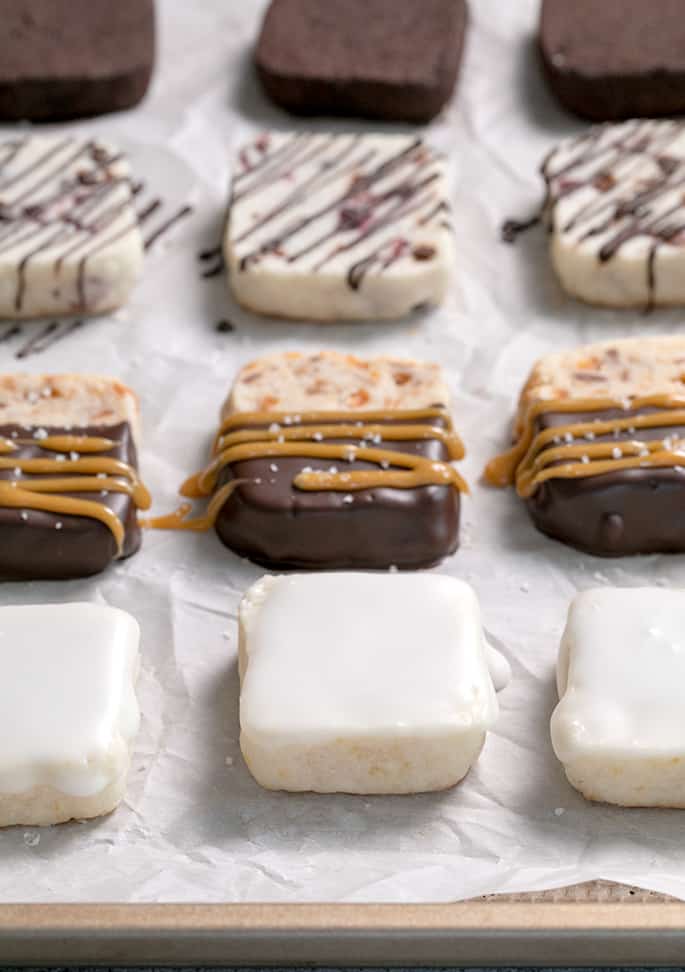
How to make gluten free shortbread cookies, step by step
Easy Gluten Free Shortbread Cookies—1 Recipe, 5 Varieties
Ingredients
Shortbread Cookie Dry Mix (345 g total)
- 1 ½ cups (210 g) all purpose gluten free flour blend (I used Better Batter)
- ¾ teaspoon xanthan gum omit if your blend already contains it
- ¼ cup (36 g) cornstarch
- ½ cup (100 g) granulated sugar
- ⅛ teaspoon kosher salt
Plain Shortbread Cookies
- 1 recipe Shortbread Cookie Dry Mix see above
- 8 tablespoons (112 g) unsalted butter softened
- Lukewarm water by the 1/2 teaspoon as needed
Mocha Shortbread Cookies
- 1 recipe Shortbread Cookie Mix see above
- 3 tablespoons (15 g) unsweetened cocoa powder (natural or Dutch-processed)
- 1 teaspoon instant espresso powder
- 8 tablespoons (112 g) unsalted butter softened
- Lukewarm water by the 1/2 teaspoon as needed
- 3 tablespoons (36 g) granulated sugar
Berry Chocolate Chip Cookies
- 1 recipe Shortbread Cookie Dry Mix see above
- 8 tablespoons (112 g) unsalted butter softened
- 2 tablespoons (30 g) chopped dried berries (I used cranberries, but dried cherries would also be great)
- 2 tablespoons (28 g) miniature semi-sweet chocolate chips
- Lukewarm water by the 1/2 teaspoon as needed
- 2 ounces semi-sweet chocolate melted (for drizzling)
Toffee Caramel Cookies
- 1 recipe Shortbread Cookie Dry Mix see above
- 8 tablespoons (112 g) unsalted butter softened
- ⅓ cup (80 g) toffee bits (I used Hershey’s Heath English Toffee Bits; the company confirmed that they are gluten free, but please do your own research)
- Lukewarm water by the 1/2 teaspoon as needed
- 4 ounces semi-sweet chocolate melted (for dipping)
- 8 Kraft caramels unwrapped, melted with 2 teaspoons milk (for drizzling)
- Coarse salt for sprinkling
Glazed Lemon Cookies
- 1 recipe Shortbread Cookie Dry Mix see above
- 2 teaspoons finely grated lemon peel
- 8 tablespoons (112 g) unsalted butter softened
- 1 tablespoon freshly squeezed lemon juice plus more by the 1/8 teaspoonful if necessary
- Lukewarm water by the 1/4 teaspoon as needed
- ½ cup (58 g) confectioners’ sugar
Instructions
Make the shortbread cookie mix.
- Place all of the cookie mix ingredients in a large bowl, and whisk to combine well. Set the dry mix aside.
- Preheat your oven to 350°F. Line a large rimmed baking sheet with unbleached parchment paper and set it aside.
To make the Plain Shortbread Cookies
- Place 1 recipe of the shortbread cookie dry mix (346 g) in a large bowl. Create a well in the center of the dry ingredients, and add the butter.
- Mix until all the dry ingredients are moistened with the butter, and then knead the dough with clean hands until it comes together. The dough should be thick and smooth.
- If necessary to bring the dough together without any dry bits, add water by the 1/2 teaspoon.
- Place the dough on a large piece of unbleached parchment paper and roll into a tight cylinder about 1 1/2-inches in diameter. Square off the sides of the cylinder as you wrap it in the parchment paper, and twist the edges of the parchment to close.
- Place in the refrigerator to chill for about 10 minutes or until firm. Remove from the refrigerator, and slice by cross-section into 15 squares, each about 3/8-inch thick.
- Place the squares about 1-inch apart from one another on the prepared baking sheet. Place in the center of the preheated oven and bake for about 8 minutes, or until set in the center and very pale brown underneath.
- Remove from the oven and allow to cool on the baking sheet for 5 minutes before transferring to a wire rack to cool completely.
To make the Mocha Shortbread Cookies.
- Place 1 recipe of the shortbread cookie dry mix, 2 tablespoons (10 g) of the cocoa powder and the espresso powder in a large bowl, and whisk to combine. Create a well in the center of the dry ingredients, and add the butter.
- Mix until all the dry ingredients are moistened with the butter, and then knead the dough with clean hands until it comes together. The dough should be thick and smooth.
- If necessary to bring the dough together without any dry bits, add water by the 1/2 teaspoon.
- Place the dough on a large piece of unbleached parchment paper and roll into a tight cylinder about 1 1/2-inches in diameter. Square off the sides of the cylinder as you wrap it in the parchment paper, and twist the edges of the parchment to close.
- Place in the refrigerator to chill for about 10 minutes or until firm. Remove from the refrigerator, and slice by cross-section into 15 squares, each about 3/8-inch thick.
- Place the remaining 1 tablespoon cocoa powder and the extra 3 tablespoons of granulated sugar in a small bowl, and mix to combine.
- Place the squares in the bowl of cocoa-sugar, one at a time, pressing the dough gently in the mixture on all sides to ensure that the sugar mixture adheres to the dough. Place the squares about 1-inch apart from one another on the prepared baking sheet.
- Place the baking sheet in the center of the preheated oven and bake for about 8 minutes, or until set in the center. Remove from the oven and allow to cool on the baking sheet for 5 minutes before transferring to a wire rack to cool completely.
To make the Berry Chocolate Chip Shortbread Cookies.
- Place 1 recipe of the shortbread cookie dry mix in a large bowl. Create a well in the center of the dry ingredients, and add the butter. Mix until all the dry ingredients are moistened with the butter.
- Add the dried chopped berries and chocolate chips, and mix until the pieces are evenly distributed throughout the dough. Knead the dough with clean hands until it comes together. It should be thick and smooth.
- If necessary to bring the dough together without any dry bits, add water by the 1/2 teaspoon.
- Place the dough on a large piece of unbleached parchment paper and roll into a tight cylinder about 1 1/2-inches in diameter. Square off the sides of the cylinder as you wrap it in the parchment paper, and twist the edges of the parchment to close. Place in the refrigerator to chill for about 10 minutes or until firm.
- Remove from the refrigerator, and slice by cross-section into 15 squares, each about 3/8-inch thick. Place the squares about 1-inch apart from one another on the prepared baking sheet.
- Place the baking sheet in the center of the preheated oven and bake for about 8 minutes, or until set in the center and very pale brown underneath.
- Remove from the oven and allow to cool on the baking sheet for 5 minutes before transferring to a wire rack to cool completely. Drizzle the melted chocolate on the tops of the cooled cookies, and allow them to sit until the chocolate is set.
To make the Toffee Caramel Shortbread Cookies.
- Place 1 recipe of the shortbread cookie dry mix in a large bowl. Create a well in the center of the dry ingredients, and add the butter. Mix until all the dry ingredients are moistened with the butter.
- Add the toffee bits, and mix until the pieces are evenly distributed throughout the dough. Knead the dough with clean hands until it comes together. It should be thick and smooth.
- If necessary to bring the dough together without any dry bits, add water by the 1/2 teaspoon.
- Place the dough on a large piece of unbleached parchment paper and roll into a tight cylinder about 1 1/2-inches in diameter. Square off the sides of the cylinder as you wrap it in the parchment paper, and twist the edges of the parchment to close. Place in the refrigerator to chill for about 10 minutes or until firm.
- Remove from the refrigerator, and slice by cross-section into 15 squares, each about 3/8-inch thick. Place the squares about 1-inch apart from one another on the prepared baking sheet.
- Place the baking sheet in the center of the preheated oven and bake for about 8 minutes, or until set in the center and very pale brown underneath.
- Remove from the oven and allow to cool on the baking sheet for 5 minutes before transferring to a wire rack to cool completely.
- Dip half of each cookie in the melted chocolate, and allow the cookies to sit until the chocolate is set. Place the caramels and milk in a small bowl, and place in the microwave for 30 seconds on 50% power. Repeat, stirring in between, until the caramels are melted and the mixture is smooth. Drizzle the melted caramel on top of the chocolate, and sprinkle lightly with coarse salt. Allow to sit until the caramel is set.
To make the Glazed Lemon Shortbread Cookies.
- Place 1 recipe of the shortbread cookie dry mix and the lemon zest in a large bowl, and whisk to combine, working out any clumps in the zest. Create a well in the center of the dry ingredients, and add the butter and 1 teaspoon of the lemon juice.
- Mix until all the dry ingredients are moistened with the butter, then knead the dough with clean hands until it comes together. It should be thick and smooth. If necessary to bring the dough together without any dry bits, add water by the 1/4 teaspoon.
- Place the dough on a large piece of unbleached parchment paper and roll into a tight cylinder about 1 1/2-inches in diameter. Square off the sides of the cylinder as you wrap it in the parchment paper, and twist the edges of the parchment to close. Place in the refrigerator to chill for about 10 minutes or until firm.
- Remove from the refrigerator, and slice by cross-section into 15 squares, each about 3/8-inch thick. Place the squares about 1-inch apart from one another on the prepared baking sheet.
- Place in the center of the preheated oven and bake for about 8 minutes, or until set in the center and very pale brown underneath. Remove from the oven and allow to cool on the baking sheet for 5 minutes before transferring to a wire rack to cool completely.
- To make the glaze, place the confectioners’ sugar in a small bowl. Add the remaining 2 teaspoons of lemon juice and mix well, until a thick paste forms.
- Add more lemon juice by the 1/4-teaspoon, mixing to combine well, until the glaze falls off the spoon slowly, in a thickly pourable glaze. Add lemon juice very slowly, as it is much easier to thin, than to thicken, the glaze.
- If you do thin the glaze too much, add more confectioners’ sugar a teaspoon at a time to thicken it. Dip the tops of the cooled cookies in the glaze and place on a flat surface to sit until the glaze is set.
Notes
Easy Gluten Free Shortbread Cookies—1 Recipe, 5 Varieties
Ingredients
Shortbread Cookie Dry Mix (345 g total)
- 1 ½ cups (210 g) all purpose gluten free flour blend (I used Better Batter)
- ¾ teaspoon xanthan gum omit if your blend already contains it
- ¼ cup (36 g) cornstarch
- ½ cup (100 g) granulated sugar
- ⅛ teaspoon kosher salt
Plain Shortbread Cookies
- 1 recipe Shortbread Cookie Dry Mix see above
- 8 tablespoons (112 g) unsalted butter softened
- Lukewarm water by the 1/2 teaspoon as needed
Mocha Shortbread Cookies
- 1 recipe Shortbread Cookie Mix see above
- 3 tablespoons (15 g) unsweetened cocoa powder (natural or Dutch-processed)
- 1 teaspoon instant espresso powder
- 8 tablespoons (112 g) unsalted butter softened
- Lukewarm water by the 1/2 teaspoon as needed
- 3 tablespoons (36 g) granulated sugar
Berry Chocolate Chip Cookies
- 1 recipe Shortbread Cookie Dry Mix see above
- 8 tablespoons (112 g) unsalted butter softened
- 2 tablespoons (30 g) chopped dried berries (I used cranberries, but dried cherries would also be great)
- 2 tablespoons (28 g) miniature semi-sweet chocolate chips
- Lukewarm water by the 1/2 teaspoon as needed
- 2 ounces semi-sweet chocolate melted (for drizzling)
Toffee Caramel Cookies
- 1 recipe Shortbread Cookie Dry Mix see above
- 8 tablespoons (112 g) unsalted butter softened
- ⅓ cup (80 g) toffee bits (I used Hershey’s Heath English Toffee Bits; the company confirmed that they are gluten free, but please do your own research)
- Lukewarm water by the 1/2 teaspoon as needed
- 4 ounces semi-sweet chocolate melted (for dipping)
- 8 Kraft caramels unwrapped, melted with 2 teaspoons milk (for drizzling)
- Coarse salt for sprinkling
Glazed Lemon Cookies
- 1 recipe Shortbread Cookie Dry Mix see above
- 2 teaspoons finely grated lemon peel
- 8 tablespoons (112 g) unsalted butter softened
- 1 tablespoon freshly squeezed lemon juice plus more by the 1/8 teaspoonful if necessary
- Lukewarm water by the 1/4 teaspoon as needed
- ½ cup (58 g) confectioners’ sugar
Instructions
Make the shortbread cookie mix.
- Place all of the cookie mix ingredients in a large bowl, and whisk to combine well. Set the dry mix aside.
- Preheat your oven to 350°F. Line a large rimmed baking sheet with unbleached parchment paper and set it aside.
To make the Plain Shortbread Cookies
- Place 1 recipe of the shortbread cookie dry mix (346 g) in a large bowl. Create a well in the center of the dry ingredients, and add the butter.
- Mix until all the dry ingredients are moistened with the butter, and then knead the dough with clean hands until it comes together. The dough should be thick and smooth.
- If necessary to bring the dough together without any dry bits, add water by the 1/2 teaspoon.
- Place the dough on a large piece of unbleached parchment paper and roll into a tight cylinder about 1 1/2-inches in diameter. Square off the sides of the cylinder as you wrap it in the parchment paper, and twist the edges of the parchment to close.
- Place in the refrigerator to chill for about 10 minutes or until firm. Remove from the refrigerator, and slice by cross-section into 15 squares, each about 3/8-inch thick.
- Place the squares about 1-inch apart from one another on the prepared baking sheet. Place in the center of the preheated oven and bake for about 8 minutes, or until set in the center and very pale brown underneath.
- Remove from the oven and allow to cool on the baking sheet for 5 minutes before transferring to a wire rack to cool completely.
To make the Mocha Shortbread Cookies.
- Place 1 recipe of the shortbread cookie dry mix, 2 tablespoons (10 g) of the cocoa powder and the espresso powder in a large bowl, and whisk to combine. Create a well in the center of the dry ingredients, and add the butter.
- Mix until all the dry ingredients are moistened with the butter, and then knead the dough with clean hands until it comes together. The dough should be thick and smooth.
- If necessary to bring the dough together without any dry bits, add water by the 1/2 teaspoon.
- Place the dough on a large piece of unbleached parchment paper and roll into a tight cylinder about 1 1/2-inches in diameter. Square off the sides of the cylinder as you wrap it in the parchment paper, and twist the edges of the parchment to close.
- Place in the refrigerator to chill for about 10 minutes or until firm. Remove from the refrigerator, and slice by cross-section into 15 squares, each about 3/8-inch thick.
- Place the remaining 1 tablespoon cocoa powder and the extra 3 tablespoons of granulated sugar in a small bowl, and mix to combine.
- Place the squares in the bowl of cocoa-sugar, one at a time, pressing the dough gently in the mixture on all sides to ensure that the sugar mixture adheres to the dough. Place the squares about 1-inch apart from one another on the prepared baking sheet.
- Place the baking sheet in the center of the preheated oven and bake for about 8 minutes, or until set in the center. Remove from the oven and allow to cool on the baking sheet for 5 minutes before transferring to a wire rack to cool completely.
To make the Berry Chocolate Chip Shortbread Cookies.
- Place 1 recipe of the shortbread cookie dry mix in a large bowl. Create a well in the center of the dry ingredients, and add the butter. Mix until all the dry ingredients are moistened with the butter.
- Add the dried chopped berries and chocolate chips, and mix until the pieces are evenly distributed throughout the dough. Knead the dough with clean hands until it comes together. It should be thick and smooth.
- If necessary to bring the dough together without any dry bits, add water by the 1/2 teaspoon.
- Place the dough on a large piece of unbleached parchment paper and roll into a tight cylinder about 1 1/2-inches in diameter. Square off the sides of the cylinder as you wrap it in the parchment paper, and twist the edges of the parchment to close. Place in the refrigerator to chill for about 10 minutes or until firm.
- Remove from the refrigerator, and slice by cross-section into 15 squares, each about 3/8-inch thick. Place the squares about 1-inch apart from one another on the prepared baking sheet.
- Place the baking sheet in the center of the preheated oven and bake for about 8 minutes, or until set in the center and very pale brown underneath.
- Remove from the oven and allow to cool on the baking sheet for 5 minutes before transferring to a wire rack to cool completely. Drizzle the melted chocolate on the tops of the cooled cookies, and allow them to sit until the chocolate is set.
To make the Toffee Caramel Shortbread Cookies.
- Place 1 recipe of the shortbread cookie dry mix in a large bowl. Create a well in the center of the dry ingredients, and add the butter. Mix until all the dry ingredients are moistened with the butter.
- Add the toffee bits, and mix until the pieces are evenly distributed throughout the dough. Knead the dough with clean hands until it comes together. It should be thick and smooth.
- If necessary to bring the dough together without any dry bits, add water by the 1/2 teaspoon.
- Place the dough on a large piece of unbleached parchment paper and roll into a tight cylinder about 1 1/2-inches in diameter. Square off the sides of the cylinder as you wrap it in the parchment paper, and twist the edges of the parchment to close. Place in the refrigerator to chill for about 10 minutes or until firm.
- Remove from the refrigerator, and slice by cross-section into 15 squares, each about 3/8-inch thick. Place the squares about 1-inch apart from one another on the prepared baking sheet.
- Place the baking sheet in the center of the preheated oven and bake for about 8 minutes, or until set in the center and very pale brown underneath.
- Remove from the oven and allow to cool on the baking sheet for 5 minutes before transferring to a wire rack to cool completely.
- Dip half of each cookie in the melted chocolate, and allow the cookies to sit until the chocolate is set. Place the caramels and milk in a small bowl, and place in the microwave for 30 seconds on 50% power. Repeat, stirring in between, until the caramels are melted and the mixture is smooth. Drizzle the melted caramel on top of the chocolate, and sprinkle lightly with coarse salt. Allow to sit until the caramel is set.
To make the Glazed Lemon Shortbread Cookies.
- Place 1 recipe of the shortbread cookie dry mix and the lemon zest in a large bowl, and whisk to combine, working out any clumps in the zest. Create a well in the center of the dry ingredients, and add the butter and 1 teaspoon of the lemon juice.
- Mix until all the dry ingredients are moistened with the butter, then knead the dough with clean hands until it comes together. It should be thick and smooth. If necessary to bring the dough together without any dry bits, add water by the 1/4 teaspoon.
- Place the dough on a large piece of unbleached parchment paper and roll into a tight cylinder about 1 1/2-inches in diameter. Square off the sides of the cylinder as you wrap it in the parchment paper, and twist the edges of the parchment to close. Place in the refrigerator to chill for about 10 minutes or until firm.
- Remove from the refrigerator, and slice by cross-section into 15 squares, each about 3/8-inch thick. Place the squares about 1-inch apart from one another on the prepared baking sheet.
- Place in the center of the preheated oven and bake for about 8 minutes, or until set in the center and very pale brown underneath. Remove from the oven and allow to cool on the baking sheet for 5 minutes before transferring to a wire rack to cool completely.
- To make the glaze, place the confectioners’ sugar in a small bowl. Add the remaining 2 teaspoons of lemon juice and mix well, until a thick paste forms.
- Add more lemon juice by the 1/4-teaspoon, mixing to combine well, until the glaze falls off the spoon slowly, in a thickly pourable glaze. Add lemon juice very slowly, as it is much easier to thin, than to thicken, the glaze.
- If you do thin the glaze too much, add more confectioners’ sugar a teaspoon at a time to thicken it. Dip the tops of the cooled cookies in the glaze and place on a flat surface to sit until the glaze is set.

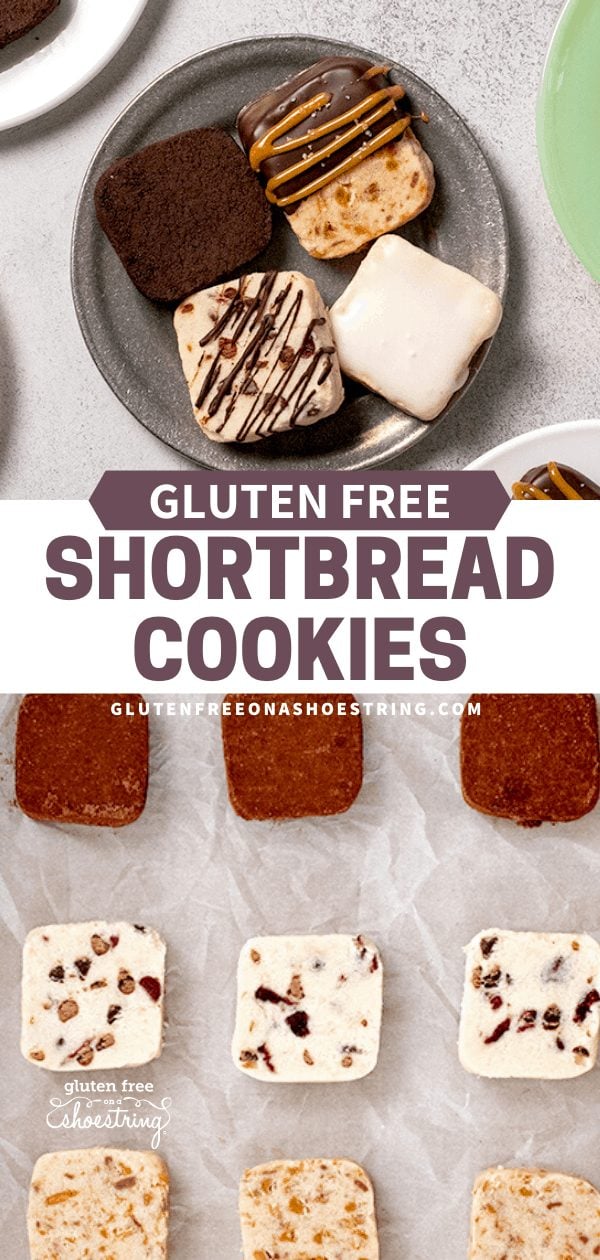

Gwen Settle says
I am making the for a gathering this Friday. Will these freeze well when baked? I have a ton to make and want to get a headstrart on them? Also, will this dough do well in a shortbread mold?
Nicole Hunn says
Hi, Gwen, Yes, they freeze very well. Shortbread, by nature, is somewhat crumbly, though. So I would freeze the cookies in a single layer on a baking sheet, then put them in a hard-sided container (not a bag, where they’ll knock around). I haven’t tried using a mold, but I don’t see any reason why it wouldn’t work perfectly well. Hope that helps!